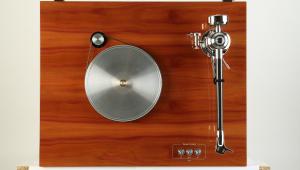Mcintosh Mt5 Belt Driven Turntable System (£7495)

Vinyl rookies will appreciate the pre-aligned cartridge already mounted in a prefitted arm. Some will love its brightly lit platter and backlit front panel (echoing classic McIntosh electronics). And on audition this deck proves far more capable than its styling may suggest. In fact, it is made for the American company by Clearaudio with its own components.
Its foundations consist of a solid stainless steel base with a thick alloy base plate with internal damping, and an acrylic top plate. The inner platter, about the size of a CD, is made of anodised aluminium. It sits on a magnetic bearing, so the heavy outer platter actually presents a lowish load on the bearing.
This is made from a special silicone-acrylic material, and its 2.3kg mass provides a flywheel action to assist stable playback. Drive is by a Swiss-made DC motor, controlled by a servo system to compensate for load and/or mains fluctuations, and offering 33.3, 45 and 78rpm speeds, each with a trim pot to set absolute pitch.
The height-adjustable 9in tonearm looks and feels robust. Made from duraluminum alloy tubing with a proprietary internal damping material, it has ceramic-surfaced high precision vertical bearings and sports a magnetic bias adjuster. Prefitted is a Sumiko Blue Point No. 2 high output MC cartridge, with an alloy cantilever and elliptical diamond stylus.
A real ‘thump’…
After settling down, the McIntosh MT5 proved a surprisingly strong performer. What’s most appealing is its combination of smoothness and power. For example, cue up Deodato’s Night Cruiser [Warner], and the rhythm track sounds satisfyingly meaty, with a powerful kick-drum and snare sound set behind some really impactful keyboard work. Bass guitar is supple, and blends into the mix tightly behind the bass drum to give a real ‘thump’ to the deepest low frequencies.
At the same time the snare work and other percussion elements drive the song along in a surprisingly positive and purposeful way. Tonally it’s beautifully rendered, being bright and sonorous with real ‘rasp’, yet it never becomes hard or shouty.
It’s this combination of a powerful bass and an open, well-lit midband, that gives the deck real appeal – a smooth, detailed treble is the icing on the cake. There’s a pleasing silkiness to the McIntosh’s sound across the presence region.
The MT5’s control pays dividends with more complex, layered music. Be Bop Deluxe’s Modern Music [Harvest], is a wash of wailing guitars from the golden age of British rock, and is full of fussy percussion work and time-changes which are a chore for less able turntables. The MT5 rose to the challenge, showing consummate control of the fluid drum-kit work and laid-back backing piano.
However, while it is great at setting up a vast, punchy, musical groove which suits rock, jazz and dance down to a tee,
classical programme material isn’t always so amenable. With Dvořák’s ‘New World’ Symphony [Philharmonia/Sawallisch – Columbia], its imaging faltered. The massed strings and brass towards the end of the first movement sounded a little diminished and opaque.
As it turns out, the prefitted cartridge was partly to blame for this, for while the Sumiko is a blast with punchier material it can lack finesse and insight into what’s going on deep down in the groove. Replace it with, say, a Lyra Delos MC and you’ll have a far more rounded musical experience that doesn’t strip out the fine timbral detail.
Verdict
Although the MT5 may have been intended as an addition to an existing McIntosh system, it stands up well in out-and-out performance terms. If you can look beyond its ‘bling’ then you may be smitten.
Originally published in the 2014 Yearbook


























































